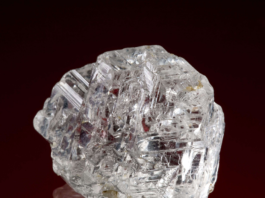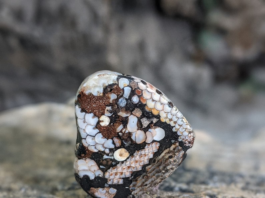Mexican Cantera Fire Opal is a vibrant and colorful gemstone that is distinctive due to its unique formation within the host rock, typically rhyolite. The term “Cantera” in Spanish means “quarry,” referencing the method of extracting these stones embedded in their matrix, unlike many opals which are typically found as loose nodules. This method preserves a natural, rugged aesthetic with the opal often showcased within a beautifully contrasting rhyolitic base.

Mexican Cantera Fire Opals are noted for their fiery play of colors, ranging from vivid reds and oranges to yellows, though they do not always exhibit the play-of-color typical of other opals. The colors can be quite intense, making these opals particularly prized for their beauty and rarity.
The distinctiveness of Mexican gemstones, such as the Cantera Fire Opal, lies in their unique geological formations and rich, varied color palette. Mexico’s volcanic regions provide a perfect environment for the formation of these and other stones, contributing to their unique characteristics and appeal. This not only makes Mexican gemstones like the Cantera Fire Opal appealing to collectors and jewelers but also adds significant cultural and economic value to the regions where they are found.
Contents
- Geology of Cantera Fire Opal
- Formation of Cantera Fire Opal
- Locations of Cantera Fire Opal Mining
- Types of Cantera Fire Opals and Their Characteristics
- Gemological Properties
- Physical Properties of Cantera Fire Opal
- Visual Characteristics
- Comparison with Other Types of Opals
- Uses and Economic Impact
- Uses of Cantera Fire Opal
- Economic Impact
Geology of Cantera Fire Opal

Formation of Cantera Fire Opal
Cantera Fire Opal forms geologically within the matrix of rhyolite, a volcanic rock. The formation process begins when silica-rich water seeps into the cavities and cracks of rhyolite lava flows. Over time, as the water evaporates under intense geological heat and pressure, the silica deposits solidify into opal. The presence of trace elements and varying conditions during the formation process lead to the diverse colors seen in these opals, particularly the fiery reds, oranges, and yellows that are characteristic of Cantera Fire Opals. This type of opal is unique because it is mined directly from its host rock, preserving the natural interplay between the gem and its geological surroundings.
Locations of Cantera Fire Opal Mining
Cantera Fire Opal is primarily found in Mexico, with significant deposits located in the states of:
- Querétaro: This region is famous for its vibrant red and orange fire opals, often found with a beautiful translucence.
- Jalisco: Known for producing a variety of fire opal with rich colors and sometimes a full spectrum play-of-color.
- Nayarit and Hidalgo: These areas also have occurrences of fire opals, although they are less well-known compared to Querétaro and Jalisco.
These regions have the volcanic soil and geological history necessary for the formation of Cantera Fire Opals, making them primary sources of these precious gems.
Types of Cantera Fire Opals and Their Characteristics
Cantera Fire Opals can vary significantly in appearance, depending on the specific conditions under which they were formed:
- Colorless to Full Spectrum: While typically known for their bright red, orange, and yellow hues, some Cantera Fire Opals can be colorless or display a full spectrum of colors, similar to other types of opals.
- Translucent to Opaque: The translucency of these opals can vary. Some stones are completely opaque, while others may be semi-transparent, enhancing their color play.
- With or Without Play-of-Color: Unlike many traditional opals, not all Cantera Fire Opals exhibit play-of-color. Some are appreciated just for their deep, intrinsic colors without the color-changing qualities.
Each type of Cantera Fire Opal holds its own appeal due to these variations, making them highly sought after for both gem collectors and jewelry makers. The natural state in which they are often left—embedded within their rhyolite matrix—adds to their rustic charm and aesthetic value.
Gemological Properties

Physical Properties of Cantera Fire Opal
- Color: The range of colors in Cantera Fire Opals includes vibrant reds, oranges, and yellows, though some specimens may be colorless or display a broader spectrum of hues.
- Transparency: These opals can vary from opaque to translucent, with the degree of transparency influencing the perceived depth and vividness of color.
- Refractive Index: Cantera Fire Opals typically have a refractive index in the range of 1.37 to 1.52, similar to other types of opal.
- Hardness: On the Mohs scale of mineral hardness, Cantera Fire Opals generally range from 5.5 to 6.5, making them relatively softer than many other gemstones and susceptible to scratching and wear if not handled carefully.
Visual Characteristics
- Play of Color: Not all Cantera Fire Opals exhibit the characteristic play of color—that is, the shifting rainbow hues seen in some opals. Many are prized instead for their solid body color.
- Clarity: The clarity of these opals can vary widely. Some stones may include inclusions or imperfections, which can detract from or enhance their appearance, depending on the nature and placement of these features.
- Common Cuts in Jewelry: Cantera Fire Opals are often cut in a way that retains part of their original rhyolite matrix, emphasizing their natural origin and rustic beauty. Common cuts include cabochons, which are polished but not faceted, to enhance their color and maximize the display of any play of color.
Comparison with Other Types of Opals
- Formation and Structure: Unlike common opals, which are typically mined as nodules or veins within a host rock and without a play of color, Cantera Fire Opals are mined within their rhyolite matrix and may or may not show play of color. Common opals are amorphous silica with a significant amount of water, while fire opals, including Cantera, often have a lower water content, which contributes to their distinctiveness in color and form.
- Color Range and Presentation: While traditional opals (like Australian opals) are famed for their vibrant play of colors across the spectrum, Cantera Fire Opals are primarily known for their intense body colors of reds, oranges, and yellows. The absence of play of color in many Cantera Opals sets them apart from other opal varieties which typically showcase this phenomenon.
- Hardness and Wearability: Cantera Fire Opals, like all opals, are relatively soft compared to harder gemstones like diamonds and sapphires. However, their hardness is similar to other types of opals, requiring careful handling and appropriate settings to minimize wear and tear.
These distinctions make Cantera Fire Opals a unique and highly valued type of opal in the gemological world, with each stone offering a unique appeal depending on its individual characteristics and the way it is cut and set in jewelry.
Uses and Economic Impact

Uses of Cantera Fire Opal
Jewelry
The most prominent use of Cantera Fire Opal is in jewelry making. The vibrant colors and unique appearance of these opals make them highly sought after for use in rings, necklaces, earrings, and other ornamental pieces. Their natural state, often still embedded in the matrix, provides a rustic and organic charm, which is particularly appealing in unique or artisan jewelry designs.
Collectibles
Cantera Fire Opals are also valued as collectibles. Gem collectors appreciate the distinct qualities and variations found in these stones, particularly those that exhibit unusual colors or patterns. Their rarity and specific regional origin add to their value as collectible items.
Artistic and Decorative Use
In addition to wearable art, Cantera Fire Opals can be used in other decorative capacities, such as inlays in furniture, decorative tiles, and other fine art applications. The unique aesthetic appeal of the stone, especially when presented in its natural matrix, enhances its versatility and allure in various artistic domains.

Economic Impact
Regional Economic Benefits
The mining and sale of Cantera Fire Opals provide significant economic benefits to the regions in Mexico where they are found. These areas often rely on the mining industry as a key economic driver. The trade in Cantera Fire Opals supports local economies through direct employment in mining and related industries, such as gem cutting and jewelry manufacturing.
Tourism
The allure of Cantera Fire Opals also contributes to tourism in regions known for their opal mines. Tourists may visit these areas not only to purchase the gems but also to learn about their history and the processes involved in their extraction and refinement. This type of tourism supports local businesses, including retail shops, hotels, and restaurants.
Global Market
On a broader scale, the export of Cantera Fire Opals contributes to Mexico’s position in the global gemstone market. The uniqueness of these opals helps to attract international buyers and collectors, enhancing Mexico’s reputation as a source of high-quality and distinctive gemstones. This not only brings in foreign exchange but also elevates the country’s status in the global gem and jewelry industry.
Overall, Cantera Fire Opals play a significant role in both local and global economies, driven by their unique geological characteristics and the aesthetic and cultural value they carry. Their extraction, processing, and sale provide vital income streams and employment opportunities in their regions of origin, while also contributing to cultural and economic exchanges on a global scale.






